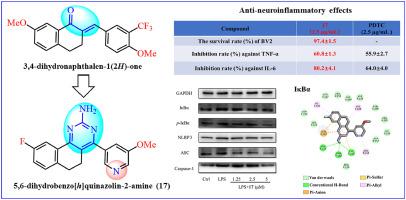European Journal of Medicinal Chemistry ( IF 6.0 ) Pub Date : 2022-03-26 , DOI: 10.1016/j.ejmech.2022.114322 Xiao-Fan Zhang 1 , Ming-Zhu Luan 1 , Wei-Bin Yan 2 , Feng-Lan Zhao 1 , Yun Hou 2 , Gui-Ge Hou 2 , Qing-Guo Meng 1

|
Neuroinflammation is an intricate process that is associated with both normal and pathological conditions. Microglia-mediated neuroinflammation is known to lead to various neurodegenerative and neurological disorders. A series of 3,4-dihydronaphthalen-1(2H)-one derivatives (1-15) and novel 5,6-dihydrobenzo[h]quinazolin-2-amine derivatives (16–30) were synthesized and characterized by various analytical methods, such as NMR and HRMS. All compounds were evaluated for toxicity, screened for their anti-neuroinflammatory properties, and investigated for the potential molecular mechanism of lipopolysaccharide (LPS) induction in BV2 microglia. Structure activity relationship analysis showed that compound 17 substituted by the 7-fluorine atom on the A-ring and the 3-methoxy on the D-ring had more potential anti-neuroinflammatory activity by inhibiting the secretion of cytokines TNF-α and IL-6. The results of western blotting assay showed that 17 significantly blocked the activation and phosphorylation of IκBα, significantly reduce the expression of NLRP3 inflammatory vesicle-associated proteins, and thus inhibit the activation of NF-κB pathway. Thus, compound 17 was demonstrated to be an excellent potential therapeutic agent for the treatment of neuroinflammation-related diseases.
中文翻译:

新型 5,6-二氢苯并[h]喹唑啉-2-胺衍生物在脂多糖刺激的 BV2 小胶质细胞中的抗神经炎症作用
神经炎症是一个与正常和病理状况相关的复杂过程。已知小胶质细胞介导的神经炎症会导致各种神经退行性和神经系统疾病。合成了一系列 3,4-dihydronaphthalen-1(2 H )-one 衍生物 ( 1 - 15 ) 和新型 5,6-dihydrobenzo[h]quinazolin-2-amine 衍生物 ( 16 - 30 ),并通过各种分析方法对其进行了表征。 NMR 和 HRMS 等方法。所有化合物都进行了毒性评估,筛选了它们的抗神经炎症特性,并研究了 BV2 小胶质细胞中脂多糖 (LPS) 诱导的潜在分子机制。构效关系分析表明,化合物17被A环上的7-氟原子和D-环上的3-甲氧基取代,通过抑制细胞因子TNF-α和IL-6的分泌,具有更强的抗神经炎症活性。Western blotting检测结果显示,17显着阻断了IκBα的活化和磷酸化,显着降低了NLRP3炎性囊泡相关蛋白的表达,从而抑制了NF-κB通路的激活。因此,化合物17被证明是一种极好的潜在治疗剂,用于治疗神经炎症相关疾病。






























 京公网安备 11010802027423号
京公网安备 11010802027423号